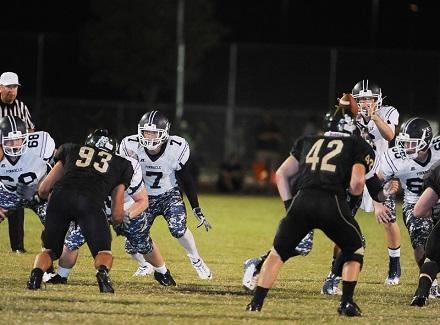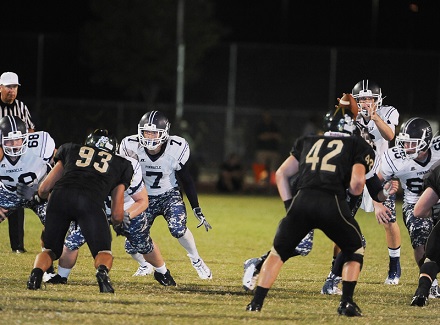

Buckle your seat belts, event owners. It’s going to be a bumpy fall. While it’s impossible for the NFHS survey data to be the fault of accusations levied against the NFL by former Baltimore Ravens fullback Le'Ron McClain, it’s likely they’ll won’t help the sport’s case among parents.
Although the actual number of participants in boys 11-player football has been going down for five consecutive years, this year’s decline was one of the largest in decades – nearly 31,000 fewer high school students enrolled in their varsity programs since last year.
“While we recognize that the decline in football participation is due, in part, to concerns about the risk of injury, we continue to work with our member state associations, the nation’s high schools and other groups to make the sport as safe as possible,” noted Dr. Karissa Niehoff, NFHS executive director. “Every state has enacted rules that limit the amount of contact before the season and during practices, and every state has concussion protocols and laws in place, so we continue to believe that the sport is as safe as it has ever been. We also are working with groups such as USA Football to reduce contact and teach proper tackling skills at the youth levels to increase the interest level as kids reach junior high school and high school.”
McClain, however, noted in his profanity-laced screed that he had started playing in high school – something that is more likely to attract the attention of parents.
"I have to get my head checked," McClain tweeted on Aug. 24. "Playing fullback since high school. Its takes too f------ much to do anything. My brain is f------ tired.... @NFL i need some help with this s--t. Dark times and its showing. F------ help me please!! They dont care I had to get lawyers man!" His most recent tweet was more anxious, asking readers to “please just pray for me.”
McClain’s Twitter outburst also touched on something many have been afraid to put into words: quarterbacks, often viewed as the stars of the team, are better protected and get far more attention to their injuries, while players who take more hits (fullbacks being one example) are temporarily sidelined, then put back in.
The NFL’s bureaucracy has been slow to respond. According to reports, a federal judge overseeing the NFL concussion settlement fired three of four lawyers serving as class counsel in May. The court also ordered players to be seen by medical expert within 150 miles of their home, which players said would (possibly intentionally) prevent them from receiving diagnostics and treatment, according to ESPN.
Football event owners should be ready for concerns. While right now, there are still plenty of youth travel programs out there – with robust attendance – it’s likely that McClain’s highly publicized concerns, and those of other football players, will affect parents who are looking for a sport to for their children long before they reach high school age.
At the same time, there are other factors that could threaten youth football. According to an article in Forbes, a number of factors are coming into play.
As far back as last year, on ACC Media Day, North Carolina coach Larry Fedora noted, “Our game is under attack ... I fear that the game will be pushed so far from what we know that we won’t recognize it 10 years from now.”
Fedora seems to be more worried about the form of the game changing along more than the number of players; with different safety measures coming into play, it’s likely it will change. How much remains to be seen – and likely will hinge on whether participation continues to decline.
However, as the Forbes article notes, it’s more than fear of injury that is affecting football. Early specialization in one sport, which leads to students eschewing the chance to be three-season athletes, means that they will pursue something other than football. Additionally, the article notes, players may not find football to have the ROI they want:
“There was a time when being a football player was practically a ticket to high school popularity and stardom. Not that football players aren't still popular people, but certainly in my kids' time the hero-worship toward football players -- from students and the community -- is far below what it was when I went to high school in the 1980s. Plus, you could end up practicing long hours, and never playing, for coaches who scream at you and try to make you feel bad about playing Fortnite. Or you could spend that time getting a job. The bottom line is, if you're not playing, it's pretty easy to find something else to do, and not lose any reflected glory.”
Additionally, there is a smaller pool of players to choose from, period: “In 2015, the latest U.S. Census information available, there were 10.6 million males ages 15 to 19 -- down from 11.3 million in the 2010 Census. The age groups younger than 15-19 have even lower numbers. Football, which in most places is a no-cut sports, relies on a large supply on raw material to fill out its depth, and that raw material is getting harder to find.”
While football is, in fact, a sport where there are full athletic scholarships (although the odds are against it), the fact is that parents are still steering children away from the sport. Lacrosse has become the white-collar sport of choice, says Forbes. The sport has been trending up faster and longer than football has been declining, attributable to the fact that because it originated in the Northeast and was originally the purview of private prep schools, lacrosse has much more of a social cache than football and is seen as a means of moving into that big Wall Street job some day. Football, not so much.
Whether the downturn in football at the youth level continues remains to be seen. One thing is for certain, though: the threats surrounding it aren’t all concussion-related, and none of them will go away any time soon.

